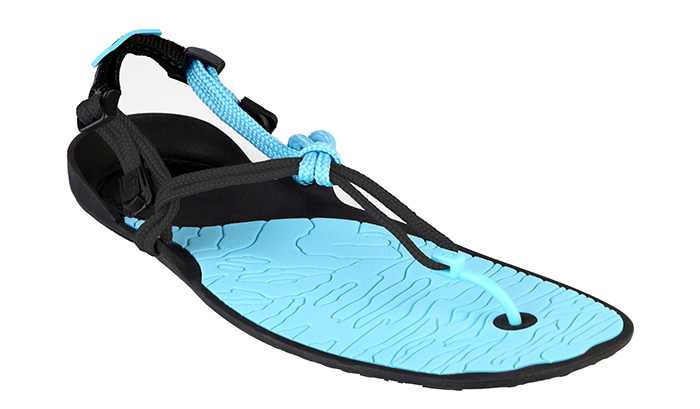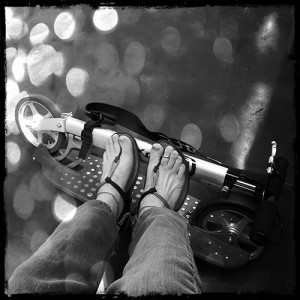[Frederik’s Note: Xero Shoes provided me with a pair of barefoot sandals to review. All opinions expressed are 100% mine.]
The most telling moment in Steven Sashen and Lena Phoenix’s appearance on Shark Tank isn’t the moment they refuse a shark’s offer, as dramatic as it is, but rather when they walk onto the set wearing the barefoot sandals that define their Xero Shoes business. For a moment, it seems as if the shark’s eyes flick downwards towards their sandal-clad feet – an impression reinforced by a camera closeup. All that’s missing is a thought bubble over the shark’s heads asking, “Who let these hippies into the tank?”
It’s a small hint at one of society’s most curious attitudes, a tangible weirdness when it comes to those trusty appendages that let us move around. That weirdness manifests itself anywhere on a spectrum that starts from a total freak-out at the sight of feet to the occasionally unsettling obsessiveness of the fetishists. Dominant is, of course, the fashion industry’s profitable exaltation of women’s feet, as demonstrated by the countless pairs of shoes designed and produced. It’s a strange enough situation that being barefoot or not becomes a question of etiquette – and more than that, of social status, gender identity, and economic status. What could be a “simple” matter of the comfort and good health that comes with walking as nature evolved us to walk has become, instead, a question of banging against social mores. The result: barefoot sandals for runners and bohemians, but the usual social frown everywhere else. Because, you know, bare feet aren’t “professional.”
In itself, that’s not saying much beyond the fact that it’s entirely human to make things far more complicated (and judgmental) than they need to be, which seems like a good time to blind ourselves with science.
Or not.
Consider:
- In 2011, Podiatry Today debunked the Top 10 Myths of Barefoot running with an article by Dr. Campitelli, a Fellow of the American College of Foot and Ankle Surgeons. The podiatrist refutes common misconceptions and discusses the benefits of minimalist footwear.
- In 2012, the awesomely named Dr. Rami Hashish wrote “Barefoot Running: The Science Behind the Fad,” in which he eventually adopts a classic non-committal stance: “Running magazines would lead you to believe that barefoot running reduces injury risk and potentially maximizes performance. However, it appears that, as this is a new trend, there is simply insufficient prospective data to say otherwise.”
- In 2013, The New York Times puts out a blog post with the self-explanatory title, “Is Barefoot-Style Running Best? New Studies Cast Doubt”.
When I interviewed Steven Sashen in February 2014 and trotted out the science question, he expressed some irritation – understandably. As he, and a bit of critical thinking, point out: the footwear industry is a billion-dollar-plus affair, and all these shoes with various orthotic gimmicks have to justify themselves somehow. (For stylish designer shoes, the rationale is, of course, that “beauty” is worth suffering for.) If we set aside the profit motive for sowing doubt about anything other than the latest celebrity-designed sneaker monstrosity, the barefoot question remains: Why, exactly, do we need footwear to correct for anatomy evolved precisely for the purpose of locomotion?
Yes, yes, I know: rhetoric. Or is it? Just as we start to question how technological progress – in nutrition and agriculture, for instance – may provide foggy solutions to problems that nature already resolved, it seems entirely timely to question the fashion industry’s attempt to market the hell out of us in order to buy into the next fad. Consider: how many women report foot pain as a result of wearing high-heeled shoes? How many times do we see narrow, pointed, ill-shaped shoes result in deformed feet? How many times do we get home at night and let out that sigh of relief when we finally, finally take our shoes off?
Of course, we humans – homo disputatio, as it were – are very good at arguing in circles, so it falls to experience to sort out the fruit from the pits, especially when the media trips over its own contradictory reporting. In this spirit, I asked Steven to send me a pair of Amuri Cloud sandals for me to try out, which he kindly did. I’ve been trying them out for about 8 months, seeing how they compare to my other footwear and, most importantly, how they fit into my lifestyle (which categorically does not include running).
So how did I fare?
To put my trial in context. During weekdays, I typically commute to work on a good ol’ foot-powered scooter, putter around the office, and scooter back home in the evening. Not all my sandals are really ideal for doing both. So my hope for the Amuri Clouds was that it would prove an all-day solution that is practical while giving me the “barefoot experience” I prefer to wearing shoes.
The first few days involved getting the lacing just right. More so than other sandals I see on the market, which tend to have the intimidating DIY lacing approach inspired by the Tarahumara Indian’s sandals (huaraches), the Amuri Clouds have an adjustable lacing system that make it easy to slip the sandals on and off while maintaining a suitably snug fit.
Once I sorted out the fit and wasn’t so conscious about what was going on with my feet, the next step was to see how well the Amuri Clouds would work out on a day-to-day basis. The answer is: wonderfully well. The shoes are very durable, easy to wear, and comfortable.
Further putting them to the test, I compared them to a pair of Chaco flip-flops that used to be my reliable go-to for various jaunts. What I discovered is that where I could walk in my Clouds without any problems, the same distance in my Chacos would invariably result in hip pain. The same applied to a pair of Chaco Z sandals, which for some reason began chafing in odd locations. The only sandals in my shoe closet that achieve parity with the Clouds, although it’s not really an all-things-equal comparison, are my Kiwi Sandals, which, despite extra cushioning, more or less have the flexibility and responsiveness of barefoot sandals.
But what about going beyond the daily routine? While I haven’t gone walking hours on end in my Clouds, something I don’t often do in general, my experience has highlighted the importance of taking the time to transition. Accustomed as we are to shoes with all their supports and gimmicks, our feet need time to build up the muscles and biomechanics to move in a way that is pain- and blister-free. (The greatest attention, I think, must surely come from people who run, as running barefoot requires a different technique than running with sneakers. Xero Shoes has plenty of resources to help with that.)
As I made the Clouds a staple piece of footwear for my casual daily routine, I’ve appreciated their comfort and versatility, and the difference they make from wearing ordinary shoes. It’s easy to see how they would fit into a variety of active, and not-so-active, lifestyles. All that’s needed is a bit of a chill-out from the social footwear police, and maybe some designer attention to take a nifty sport sandal into other fashion realms.
*Disclaimer: Xero Shoes provided me with a pair of sandals for review purposes. The opinions expressed in this article are strictly my own .



One Comment on ““Walk This Way: Walking with Xero Shoes””
Thanks for your review… of course in the time since we sent you those Clouds we’ve come out with the Z-Trek (for people who don’t want something between their toes). We may have to get you a pair of those to review next 😉